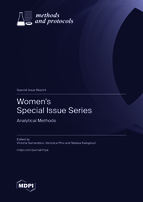Women’s Special Issue Series: Analytical Methods
A special issue of Methods and Protocols (ISSN 2409-9279). This special issue belongs to the section "Biochemical and Chemical Analysis & Synthesis".
Deadline for manuscript submissions: closed (30 September 2023) | Viewed by 21773
Special Issue Editors
Interests: analytical chemistry; sample preparation; chromatography; HPLC; method validation; method development; separation science; food analysis; bioanalysis; environmental analysis; green analytical chemistry; sorptive extraction; microextraction techniques
Special Issues, Collections and Topics in MDPI journals
Interests: microextraction methods; miniaturized analytical sample preparation; ionic liquids and derivatives; metal-organic frameworks; environmental analysis
Special Issues, Collections and Topics in MDPI journals
Interests: analytical chemistry; microextraction sample preparation techniques; high-pressure liquid chromatography; gas chromatography; high-resolution mass spectrometry; chemometrics
Special Issues, Collections and Topics in MDPI journals
Special Issue Information
Dear Colleagues,
Undoubtedly, all pivotal advances in a great number of scientific fields rely on the respective advances in chemistry. Among all fields, analytical chemistry has the leading role.
Analytical methods are necessary in dentistry, medicine (both human and veterinary), archaeology, the pharmaceutical industry, food science and technology, and environmental sciences, and these are only a few examples. The multidisciplinary role of chemistry is reflected in all important advances from research groups in every technological progress, proving that analytical chemistry is the key issue in scientific progress.
In parallel with this outstanding role of analytical chemistry in a variety of scientific fields, we would particularly like to reflect the impact of female researchers in the field of analytical chemistry in this Special Issue to serve as a motivation guide for girls and women pursuing a STEM career.
Therefore, we invite well-established scientists to share the results of their research with the scientific community through this Special Issue, which aims to compile manuscripts written or lead by women analytical chemists
Prof. Dr. Victoria Samanidou
Prof. Dr. Verónica Pino
Dr. Natasa Kalogiouri
Guest Editors
Manuscript Submission Information
Manuscripts should be submitted online at www.mdpi.com by registering and logging in to this website. Once you are registered, click here to go to the submission form. Manuscripts can be submitted until the deadline. All submissions that pass pre-check are peer-reviewed. Accepted papers will be published continuously in the journal (as soon as accepted) and will be listed together on the special issue website. Research articles, review articles as well as short communications are invited. For planned papers, a title and short abstract (about 100 words) can be sent to the Editorial Office for announcement on this website.
Submitted manuscripts should not have been published previously, nor be under consideration for publication elsewhere (except conference proceedings papers). All manuscripts are thoroughly refereed through a single-blind peer-review process. A guide for authors and other relevant information for submission of manuscripts is available on the Instructions for Authors page. Methods and Protocols is an international peer-reviewed open access semimonthly journal published by MDPI.
Please visit the Instructions for Authors page before submitting a manuscript. The Article Processing Charge (APC) for publication in this open access journal is 1800 CHF (Swiss Francs). Submitted papers should be well formatted and use good English. Authors may use MDPI's English editing service prior to publication or during author revisions.
Keywords
- analytical chemistry
- method development
- method validation
- analytical techniques
- analytical methods
- analytical applications
- female scientists









